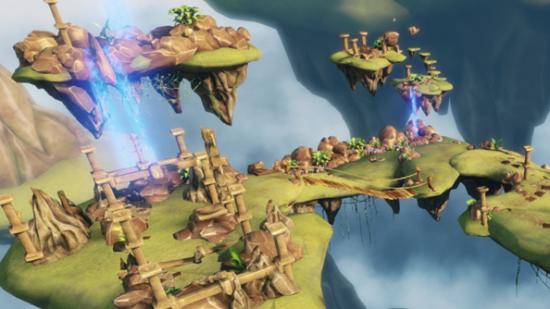Hello! Jeremy here. I’m at Gadget Show Live all this week to cover the final moments of Make Something Unreal – Epic Games’ annual UDK challenge in which hundreds of teams of European students compete for a commercial Unreal Engine 4 license. Four teams remain, and must iterate furiously on their genetics-themed prototypes in the runup to their final judging this Sunday. All aim to wear the code-crown previously donned by the nascent teams of Tripwire and Coffee Stain Studios. First up this evening is Polymorph – a 3D platformer with unexpected mutations hidden beneath its tribal tattoos.
If Kairos Games’ Polymorph is the most polished prototype in Make Something Unreal this year, as Tim once suggested, that’s because it’s been sliced and diced to the point of near-transparent beauty, like one of Gunther von Hagens’ plastinated people-slivers. Wielding the blade were Kairos’ mentors for the competition, Ninja Theory, who know a thing or two about cutting.
Project lead Kurtis Richards laughed earlier today as he described the first two pieces of feedback his team received from the DMC studio. The first? To cut their ten-level vision for their game back to something that might be doable in the four months leading up to this week’s Gadget Show Live finale. The second? C’mon guys, be realistic. Cut it back some more.
The result is two levels of 3D platforming across vivid, floating landscapes less alien than prehistoric. The player takes on the role of Axis, a buck-toothed Sylvester the Cat crossbred with Crysis’ nanosuit, and the competition theme of Mendelian inheritance ensures the crossbreeding doesn’t stop there. At various junctures throughout the game’s levels, the player will find it necessary to interact with eggs left behind by this strange world’s tribal peoples. In transferring his energy into the egg, Axis will disintegrate into a fine dust, and Axis MK2 will be hatched – with a new genetic trait gleaned from the native race.
The team are aiming for a PEGI rating of 4 or 8 years and up, and want to introduce children to the idea of genetics – but only if they’re interested.
“We don’t want to push science into people’s faces,” said Richards. “So one of the things we’re focusing on in tangential learning – you’re interacting with an egg and a new character is born anew.”
The genomics may be iffy, but that’s of small concern to the player, who gets to acquire fresh and outlandish skills at regular beats. In the level I played, I came across two eggs at a crossroads. One offered a charge ability, which I used to bludgeon my way across a rushing river like a rude Moses. If I’d picked the other, I’d have harnessed a glide move, and been able to make short work of the broken bridge down a different path.
Polymorph is all about these small binary choices. The team plan to allow players to take on three traits at once – relating to Axis’ head, torso, and legs – and tackle enemies in a personalised fashion. I could ram rhino-like Oggs using my charge move, for instance, or make a quick exit when targeted by Easter Island Statue-style turrets. But through judicious egg-selection, another player might have picked up a ranged fireball attack and armour-boosting stoneskin instead.
I played Polymorph via Xbox controller support Kairos had managed to implement just prior to the show, and found it vaguely reminiscent of the linear, yet somewhat wonderful Rayman 2. Watch my chat with Kairos’ Kurtis Richards below for more on its inspirations and what’s left to implement for this weekend’s finale.
Apologies in advance for the rumbling and ruckus of the show floor, which sometimes threatens to swallow the interview whole:
